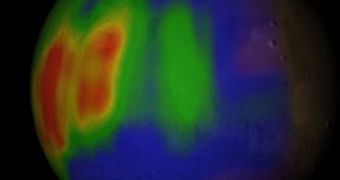The scientific instruments for the first ESA-NASA mission on Mars were finally established. The mission is scheduled for 2016 and it will study the martian atmosphere. In its chemical composition scientists discovered methane, ever since 2003, a very important clue as this could mean that there is a possibility of living on the Red Planet.
“To fully explore Mars, we want to marshal all the talents we can on Earth,” said David Southwood, ESA Director for Science and Robotic Exploration. “Now NASA and ESA are combining forces for the joint ExoMars Trace Gas Orbiter mission. Among its objectives is to characterize the planet’s atmosphere, and in particular search for trace gases like methane.”
“We got our first sniff of the gas with Mars Express in 2003,” he continued. “NASA has since clearly confirmed this. Mapping methane allows us to investigate further that most important of questions: is Mars a living planet, and if not, can or will it become so in the future?”
The two space agencies have agreed on a joint program or Mars' exploration. This is the first time that and alliance is formed for exploring a planet in our solar system. The first martian mission is called the ExoMars Trace Gas Orbiter, and its purpose is to bring a sample from the surface of the planet. On this occasion, scientists all over the world were invited to propose suitable instruments.
From the 19 proposals submitted in January 2010, as a response to the Announcement of Opportunity for this first mission, ESA and NASA selected five science instruments. The most important criteria for the selection were the scientific value and the risk. These instruments will be developed by an international team of engineers and scientists.
“Independently, NASA and ESA have made amazing discoveries up to this point,” associate administrator of NASA's Science Mission Directorate in Washington, Ed Weiler said. “Working together, we'll reduce duplication of effort, expand our capabilities and see results neither ever could have achieved alone.”
Besides the Trace Gas Orbiter, the 2016 mission will include Europe’s entry, descent and landing demonstration vehicle and the whole mission will be launched on a NASA rocket. The future mission scheduled for 2018, will carry an American rover capable of caching selected samples for potential future return to Earth, a European rover with a drill and a NASA landing system, using a NASA launcher.
The two missions are only the beginning of a collaboration between the two space agencies, that will strongly benefit Science and will give ESA and NASA more information for the joint sample-return mission on Mars, in 2020.
The instruments selected for the first mission are: the Mars Atmospheric Trace Molecule Occultation Spectrometer (MATMOS), the High-resolution solar occultation and nadir spectrometer (SOIR/NOMAD), the ExoMars Climate Sounder (EMCS), the High-resolution Stereo Color Imager (HiSCI) and the Mars Atmospheric Global Imaging Experiment (MAGIE).
The Mars Atmospheric Trace Molecule Occultation Spectrometer is an infrared spectrometer that detects very low concentrations of molecular constituents of the atmosphere. The High-resolution solar occultation and nadir spectrometer is an infrared spectrometer that detects trace constituents in the atmosphere and maps their location on the surface. The third instrument is the ExoMars Climate Sounder, an infrared radiometer that will be providing daily global measurements of dust, water vapor and chemical species in the atmosphere to help the analysis of the spectrometer data.
The High-resolution Stereo Color Imager is a camera that provides 4-color stereo images at 2 m resolution per pixel over an 8.5 km swathe. Finally, the Mars Atmospheric Global Imaging Experiment is a wide-angle multi-spectral camera necessary for providing global images in support of the other instruments.

 14 DAY TRIAL //
14 DAY TRIAL //